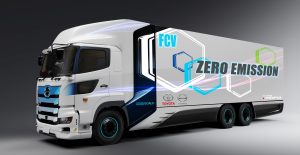Toyota and Hino to Jointly Develop Heavy-Duty Fuel Cell Truck
Toyota Motor Corporation (Toyota) and Hino Motors Ltd (Hino) have agreed to jointly develop a heavy-duty fuel cell truck and to conduct testing that leads towards its practical application.
Both Toyota and Hino have declared ambitious goals to reduce CO2 emissions by 20501 and are continuing to develop electrified vehicle technologies for widespread use. In order to achieve broader reductions in CO2 emissions, major improvements will be required in the environmental performance of heavy-duty trucks, which account for about 60 per cent of the total CO2 emissions from commercial vehicles operating in Toyota and Hino’s home market of Japan2.
For the electrification of commercial vehicles, the optimum powertrain must be adopted to ensure both environmental performance and practicality as a business vehicle, in terms of cruising range, load capacity and other commercially relevant aspects of operation. Heavy-duty trucks are typically used for inter-city transportation. Therefore, they are required to have sufficient cruising range and load capacity as well as fast refuelling capability. For this reason, fuel cell vehicles that run on hydrogen, with its high energy density, are considered effective.
The heavy-duty fuel cell truck being developed is based on Hino Profia and will take maximum advantage of the vehicle technologies delivered by Toyota and Hino over the years. The chassis is specially designed, with the optimum packaging for a fuel cell vehicle, and steps are being taken, through comprehensive weight reduction, to ensure a sufficient load capacity. The powertrain, equipped with two Toyota fuel cell stacks newly developed for Toyota’s next generation Mirai, includes elements of vehicle driving control applied through heavy-duty hybrid vehicle technologies developed by Hino.
Cruising range will be set at approximately 370 miles, aiming to meet high standards in both environmental performance and practicality as a commercial vehicle.
Toyota and Hino have positioned hydrogen as an important energy source for the future and have worked together on the development and proliferation of fuel cell technologies since conducting joint trials of a fuel cell bus in 2003. Going forward, Toyota and Hino will further strengthen this partnership and accelerate efforts toward the realisation of a hydrogen society.
Vehicle outline:
| Vehicle | Base model | Hino Profia FR1AWHG |
| Length / width / height | 11990/2490/3780 mm | |
| Total vehicle weight | 25t | |
| FC stack | Name (type) | Toyota FC Stack (Polymer electrolyte fuel cell) |
| Motor | Type | AC synchronous |
| High-pressure hydrogen tank | Developing a new large capacity high pressure (70MPa) hydrogen tank | |
| Battery | Type | Lithium ion battery |
| Cruising range (proposed) | Approx. 370 miles
*in integrated city and highway driving cycle; Toyota and Hino internal measurements |
|
*1 Toyota Environmental Challenge 2050: Established in 2015, of which one part is the New Vehicle Zero CO2 Emissions Challenge, through which Toyota aims to cut its average carbon dioxide emissions from new vehicles by 90 percent (compared to 2010 levels).
Hino Environmental Challenge 2050: Established in 2017, of which one part is the New Vehicle Zero CO2 Emissions Challenge, through which Hino aims to cut its average carbon dioxide emissions from new vehicles by 90 percent (compared to 2013 levels).
*2 Trucks and buses with gross vehicle weight of over 3.5 tons; Hino internal research, as of February 2020
ENDS


